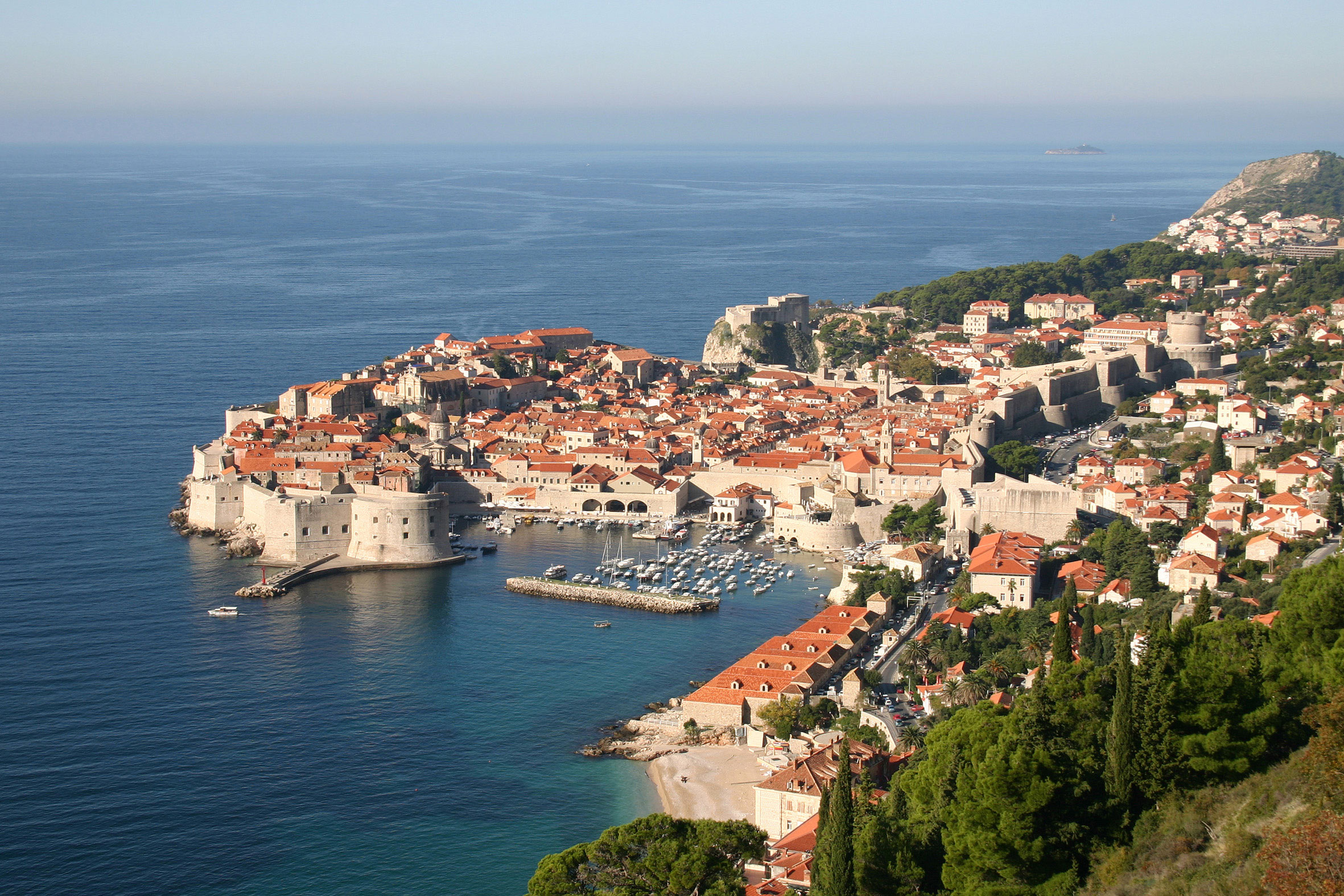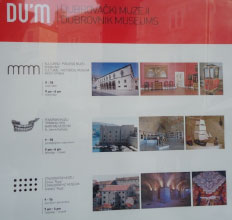 Signs advertising Dubrovnik’s Museums.
Signs advertising Dubrovnik’s Museums. 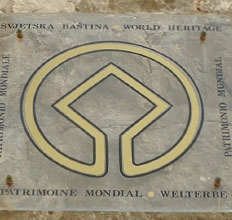 Dubrovnik’s UNESCO sign.
Dubrovnik’s UNESCO sign. 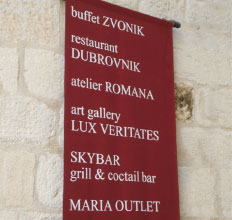 A sign advertising local businesses.
A sign advertising local businesses. Full Screen
Dubrovnik’s government is keen to manage the impacts of tourism with a sustainable approach. Sustainable tourism can be defined as ‘developments that meets the needs of the present without compromising the ability of future generations to meet their own needs’.
• The city does not want to make the same mistake as areas of Spain and allow high-rise developments in its city or along its Adriatic coastline. Any new building projects have to follow strict guidelines set by Dubrovnik government and UNESCO.
• The local people are very aware of their reliance on tourism and therefore wish to see sustainable tourism succeed so that future generations can benefit from tourism and enjoy the city. The local politicians are aware of the local’s knowledge and understanding and are therefore keen to support sustainable tourism practices.
• Local people are involved in restoration projects and other small scale projects. However, they are not always consulted on bigger projects as the government and investors have a bigger say. This can cause conflict when new roads and bridges are to be built or when areas such as the port are to be regenerated.
• The Dubrovnik Tourist Board is keen to promote its sustainable tourism credentials and is a supporter and member of organisations whose aim is to promote sustainable tourism and protect cultural attractions. For example:
Recent examples of Dubrovnik’s sustainable approach include:
• Celebrating World Tourism Day on 27th September 2102.
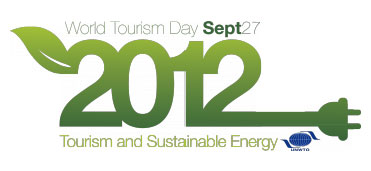
This 2012 theme is to improving energy efficiency and increasingly using renewable energy technologies in its operations. These steps are creating jobs, lifting people out of poverty and helping to protect the planet. Dubrovnik’s new HEP station, reservoir and extensive use of solar panels are examples of this approach. World Tourism Day in Dubrovnik was celebrated with music, wine and food.
• Supporting the ‘Best In Heritage’ survey
THE BEST IN HERITAGE
Dubrovnik, Croatia, 27 - 29 September 2012
‘The Best in Heritage is an international annual survey of awarded museum, heritage and conservation projects. The survey was launched in 2003 by the European Heritage Association. The event is being held every year in the city of Dubrovnik, Croatia at the end of September. The main aim of the conference is to give prize winning projects from the preceding year all the professional and media attention possible and to offer exchange of professional experiences, contacts and information. The event serves to identify and promote the best museum, heritage and conservation projects in the world. This event brings together museum and heritage professionals (architects, designers, consultants, information specialists, suppliers, tourism experts, media people etc.), various institutions and professionals from a broad range of practice and interest in the field of heritage. Since 2009, the conference has been organised in partnership with Europa Nostra’.
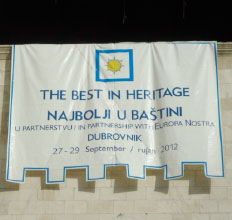
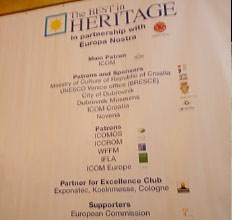

This Albert Einstein Formula For Energy Has Been Adapted By ‘The Best In Heritage’ To Emphasise Its Key Aims
http://www.thebestinheritage.com/excellence-club/introduction/
• Cooperation between the public and private sector in Dubrovnik is almost non-existent. Often the government is seen in a negative light as it does little to help the private sector and its strict regulations deter many developers.
• There is a lack of skilled and trained staff in all sectors of the travel and tourism industry. This could result in many dissatisfied visitors and Dubrovnik failing to attract the ‘elite tourists’. However, the government is investing in its education system and believes that in the long term this strategy will reap rewards.
• Visitor management - the tourist information centres, travel agencies and tour operators only promote the main attractions. This adds to the problem of overcrowding in peak times and an unfair distribution of income. Lesser attractions find it difficult to survive. The Dubrovnik Tourist Board is aware of this problem but little is being done to promote attractions and destinations outside of Dubrovnik’s city walls.
Vehicles are not allowed within the city walls, which is a great attraction as tourists can explore the old town without the problem of traffic. However, the city does not provide suitable roads and sufficient parking for the huge inflow of coaches and cars during the peak times. This often results in congestion on the city’s feeder roads and frustration for its visitors. Methods off alleviating the problem, such as ‘park and ride’ schemes are yet to be introduced.
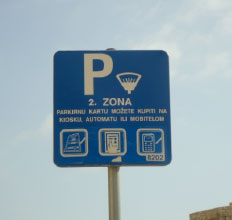
The bus station located by the entrance to the old town is often congested with local buses and coaches. This gives a poor first impression and visitors are ‘hassled’ by people promoting their bar, guest house or leisure activity. The lack of a railway station exacerbates this problem
• Overcrowding –the visitor can be bombarded by people selling boat trips and queues are extensive in the summer months. Is this a sign saying that Dubrovnik is trying to attract too many visitors in peak times? Will images such as this deter the elite tourist?
• Dubrovnik’s slogan to be a ‘city for all seasons’ is a step in the right direction as this will mean permanent jobs and a more even flow of money into the city. The city will be able to accommodate more tourists, more comfortably. However, the city will need to provide more winter events and work closely with low-cost airlines from around Europe.
• The new HEP station and reservoir should ensure there is sufficient electricity and water for the local population and its many visitors. Solar panels are used extensively in Croatia but wind farms have been developing slowly since 2004. All accommodation providers are provided with guidelines and stickers from the local government with regard to the conservation of energy and water. The recycling of waste products is in its infancy and mainly focuses on glass. Although there is greater awareness of saving water and energy the predicted rise in visitor numbers will present a challenge to Dubrovnik and its citizens.
• Transport – vehicles are not allowed within the city walls. This has helped preserve the heritage buildings as there is less chance of carbon emissions causing damage. However, there is often gridlock outside the city walls as a result of local and visitor traffic. There is a good range of public service buses within the city, to other Croatian destinations and the international airport. However, many of the buses are quite old and pollute the local air. There are no initiatives to use cooking oil for buses, electric bikes, introduce trams or any other form of sustainable transport.
• The Dubrovnik government has invested millions in the restoration of its city wall and other cultural attractions. The government is acutely aware that not maintaining the city’s heritage will adversely affect its appeal as cultural attraction. Each year the government aims to target buildings which need to be restored for future generations to enjoy. The government is already seeking EU funding for major projects before it actually joins in 2013.
• The Dubrovnik Tourist Board makes sure that any signs in the old city do not spoil the heritage environment that the great majority of tourists are there to experience (see images at the top of this page for evidence of this).
In your groups, explain why you think it is important to involve all local stakeholders in any decision making regarding major travel and tourism development projects.
